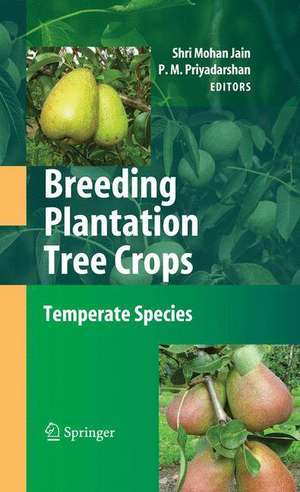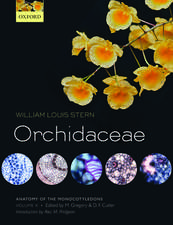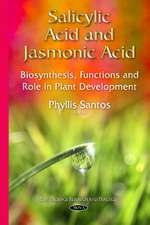Breeding Plantation Tree Crops: Temperate Species
Editat de Shri Mohan Jain, P.M. Priyadarshanen Limba Engleză Hardback – 26 oct 2008
This volume is a compilation of information on breeding of temperate tree species and provides first hand comprehensive knowledge to research, teach, and make policies.
| Toate formatele și edițiile | Preț | Express |
|---|---|---|
| Paperback (2) | 945.30 lei 6-8 săpt. | |
| Springer – 4 sep 2014 | 945.30 lei 6-8 săpt. | |
| Springer – 29 oct 2010 | 2108.66 lei 6-8 săpt. | |
| Hardback (2) | 949.73 lei 6-8 săpt. | |
| Springer – 26 oct 2008 | 949.73 lei 6-8 săpt. | |
| Springer – 23 oct 2008 | 2116.22 lei 6-8 săpt. |
Preț: 949.73 lei
Preț vechi: 1158.20 lei
-18% Nou
Puncte Express: 1425
Preț estimativ în valută:
181.79€ • 197.53$ • 152.80£
181.79€ • 197.53$ • 152.80£
Carte tipărită la comandă
Livrare economică 21 aprilie-05 mai
Preluare comenzi: 021 569.72.76
Specificații
ISBN-13: 9780387712024
ISBN-10: 038771202X
Pagini: 290
Ilustrații: X, 299 p.
Dimensiuni: 155 x 235 x 20 mm
Greutate: 0.57 kg
Ediția:2009
Editura: Springer
Colecția Springer
Locul publicării:New York, NY, United States
ISBN-10: 038771202X
Pagini: 290
Ilustrații: X, 299 p.
Dimensiuni: 155 x 235 x 20 mm
Greutate: 0.57 kg
Ediția:2009
Editura: Springer
Colecția Springer
Locul publicării:New York, NY, United States
Public țintă
ResearchCuprins
Almond (Prunus dulcis) Breeding.- Breeding Apple (Malus x Domestica Borkh).- Apricot Breeding.- Citrus Breeding.- Pear Breeding.- Plum Breeding.- Raspberry Breeding.- Breeding Walnuts (Juglans Regia).
Recenzii
From the reviews:
"Chapters are generally divided into several subsections, beginning with a botanical description of the crop and an overview of genetic resources available for breeding. The book highlights world production centers, crop uses, and value. … Chapters also cover breeding techniques and the current employment of biotechnological applications for crop improvement. … Each thoroughly referenced chapter provides an up-to-date review of literature that will be valuable for advanced readers. Summing Up: Recommended. Graduate students and above." (R. M. Warner, Choice, Vol. 46 (11), July, 2009)
"This volume is devoted to temperate fruits including two stone fruits, apricot and plums, three pome fruits, apple, pear and Citrus, a small fruit, raspberry, and two tree nuts, almond and walnut. It provides a good sample of temperate fruits and contributes effectively to presenting and understanding all aspects of breeding and crop production. … the book covers a good range of information dealing with eight major temperature fruit crops. It is well documented and appropriate for readers interested in breeding of temperature fruits species." (Françoise Dosba, Annals of Botany, Vol. 104 (6), November, 2009)
"Chapters are generally divided into several subsections, beginning with a botanical description of the crop and an overview of genetic resources available for breeding. The book highlights world production centers, crop uses, and value. … Chapters also cover breeding techniques and the current employment of biotechnological applications for crop improvement. … Each thoroughly referenced chapter provides an up-to-date review of literature that will be valuable for advanced readers. Summing Up: Recommended. Graduate students and above." (R. M. Warner, Choice, Vol. 46 (11), July, 2009)
"This volume is devoted to temperate fruits including two stone fruits, apricot and plums, three pome fruits, apple, pear and Citrus, a small fruit, raspberry, and two tree nuts, almond and walnut. It provides a good sample of temperate fruits and contributes effectively to presenting and understanding all aspects of breeding and crop production. … the book covers a good range of information dealing with eight major temperature fruit crops. It is well documented and appropriate for readers interested in breeding of temperature fruits species." (Françoise Dosba, Annals of Botany, Vol. 104 (6), November, 2009)
Textul de pe ultima copertă
Tree species, spread across a wide range of genera, are indispensible to human life. Their breeding, poised to satisfy human needs, presents significant challenges. Tree crops face a variety of agronomic and horticultural problems in propagation, yield, appearance, quality, diseases and pest control, abiotic stresses and poor shelf-life. Additionally, shrinkage of cultivable land and the pressure of growing demand have resulted in growth of tree crops under marginal conditions that call for concerted efforts for their genetic improvement. Increased attention to the environment, sustainability and diet in recent years in turn magnifies the importance of study of these crops. With the use of modern molecular and biotechnological tools, the task of improving yield in tree crops is foremost in the acumen of future global agricultural research for sustainable production.
This 2-volume book series deals with both tropical and temperate tree crop species, and represents an effort toward compilation of all available worldwide research on these subjects. This volume covers the following temperate species: almond, apple, apricot, citrus, pear, plum, raspberry and walnut. The contributing authors are internationally-known specialists who provide first hand comprehensive knowledge. All contributory book chapters have been peer reviewed and revised accordingly. This book series is an indispensable reference for scientists, researchers, teachers, students, policy makers and planters.
S. Mohan Jain, Plant Biotechnologist, University of Helsinki, Helsinki, Finland
P. M. Priyadarshan, Plant Breeder, Rubber Research Institute of India.
This 2-volume book series deals with both tropical and temperate tree crop species, and represents an effort toward compilation of all available worldwide research on these subjects. This volume covers the following temperate species: almond, apple, apricot, citrus, pear, plum, raspberry and walnut. The contributing authors are internationally-known specialists who provide first hand comprehensive knowledge. All contributory book chapters have been peer reviewed and revised accordingly. This book series is an indispensable reference for scientists, researchers, teachers, students, policy makers and planters.
S. Mohan Jain, Plant Biotechnologist, University of Helsinki, Helsinki, Finland
P. M. Priyadarshan, Plant Breeder, Rubber Research Institute of India.
Caracteristici
Covers almost all temperate tree plantation crops Serves as a reference book for all users (researchers, teachers, students) Many chapters include biotechnology and molecular components, more like a package breeding and appropriate molecular techniques Includes supplementary material: sn.pub/extras
Descriere
Descriere de la o altă ediție sau format:
Tree species are indispensable to support human life. Due to their long life cycle and environmental sensitivity, breeding trees to suit day-to-day human needs is a formidable challenge. Whether they are edible or industrial crops, improving yield under optimal, sub-optimal and marginal areas calls for uni?ed efforts from the s- entistsaroundtheworld. Whiletheuniquenessofcoconutaskalpavriksha(Sanskr- meaning tree-of-life) marks its presence in every continent from Far East to South America, tree crops like cocoa, oil palm, rubber, apple, peach, grapes and walnut prove their environmental sensitivity towards tropical, sub-tropical and temperate climates. Desert climate is quintessential for date palm. Thus, from soft drinks to breweries to beverages to oil to tyres, the value addition offers a spectrum of pr- ucts to human kind, enriched with nutritional, environmental, ?nancial, social and trade related attributes. Taxonomically, tree crops do not con?ne to a few families, but spread across a section of genera, an attribute so unique that contributes immensely to genetic biodiversity even while cultivated at the commercial scale. Many of these species in?uence other ?ora to nurture in their vicinity, thus ensuring their integrity in p- serving the genetic biodiversity. While wheat, rice, maize, barley, soybean, cassava andbananamakeup themajorfoodstaples,manyfruittreespeciescontributegreatly tonutritionalenrichment inhumandiet. Theediblepartofthesespeciesisthesource of several nutrients that makes additives for the daily diet of humans, for example, vitamins, sugars, aromas and ?avour compounds, and raw material for food proce- ing industries. Tree crops face an array of agronomic and horticultural problems in propagation, yield, appearance, quality, diseases and pest control, abiotic stresses and poor shelf-life.
Tree species are indispensable to support human life. Due to their long life cycle and environmental sensitivity, breeding trees to suit day-to-day human needs is a formidable challenge. Whether they are edible or industrial crops, improving yield under optimal, sub-optimal and marginal areas calls for uni?ed efforts from the s- entistsaroundtheworld. Whiletheuniquenessofcoconutaskalpavriksha(Sanskr- meaning tree-of-life) marks its presence in every continent from Far East to South America, tree crops like cocoa, oil palm, rubber, apple, peach, grapes and walnut prove their environmental sensitivity towards tropical, sub-tropical and temperate climates. Desert climate is quintessential for date palm. Thus, from soft drinks to breweries to beverages to oil to tyres, the value addition offers a spectrum of pr- ucts to human kind, enriched with nutritional, environmental, ?nancial, social and trade related attributes. Taxonomically, tree crops do not con?ne to a few families, but spread across a section of genera, an attribute so unique that contributes immensely to genetic biodiversity even while cultivated at the commercial scale. Many of these species in?uence other ?ora to nurture in their vicinity, thus ensuring their integrity in p- serving the genetic biodiversity. While wheat, rice, maize, barley, soybean, cassava andbananamakeup themajorfoodstaples,manyfruittreespeciescontributegreatly tonutritionalenrichment inhumandiet. Theediblepartofthesespeciesisthesource of several nutrients that makes additives for the daily diet of humans, for example, vitamins, sugars, aromas and ?avour compounds, and raw material for food proce- ing industries. Tree crops face an array of agronomic and horticultural problems in propagation, yield, appearance, quality, diseases and pest control, abiotic stresses and poor shelf-life.







